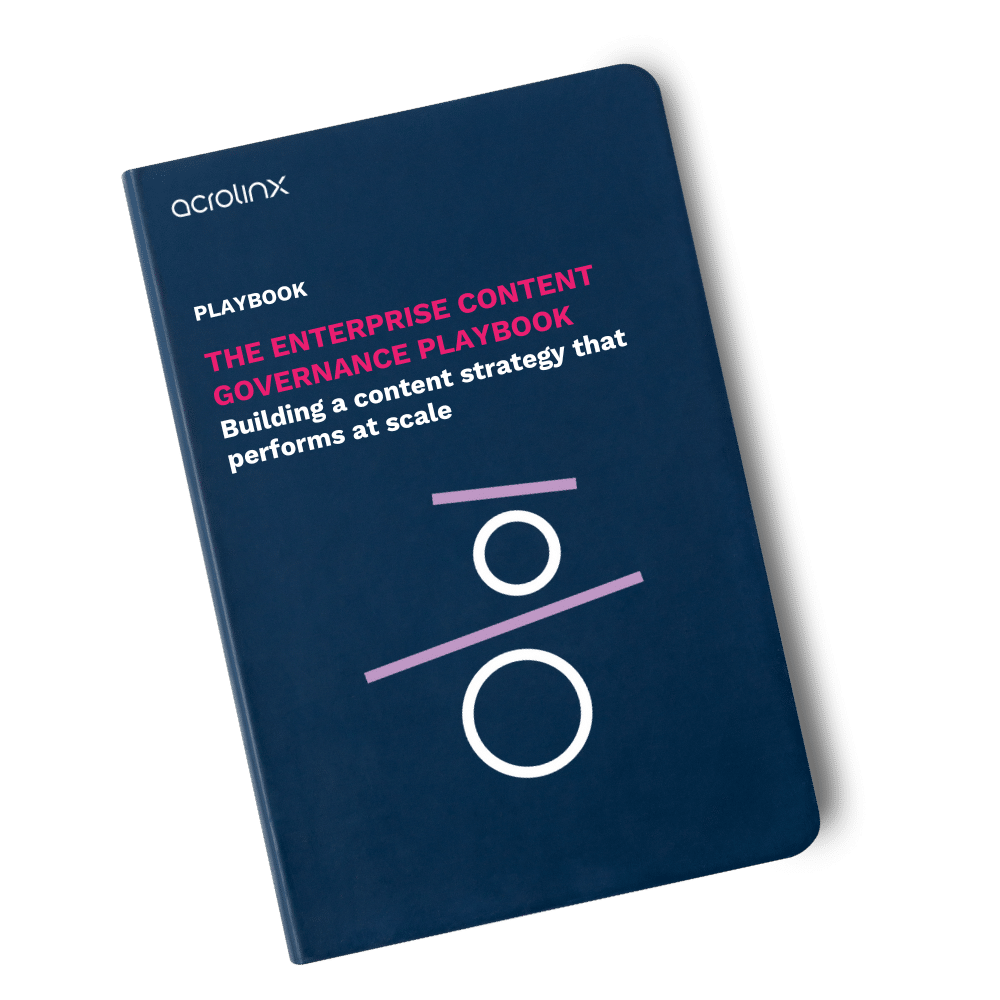
Editor’s note: This blog article, written by Acrolinx CMO Christopher Willis, originally appeared in TechCrunch in December 2022. You can find the original article here.
Content is the core of customer experience. A company’s product or service can be phenomenal, but if the enterprise content — marketing, messaging, customer service communications, product documentation or even brand voice and style — is poorly written or unfocused, you’ll have a difficult time attracting and retaining customers.
That’s where content governance comes in. It involves taking a systematic approach to measuring your current content’s status and actively guiding content creation to achieve your stated goals, such as increasing sign-ups for a newsletter or increasing conversion rates. Content governance systems take the key elements of a style guide and content strategy and turn them into even more thorough, usable and holistic frameworks for your entire company. It goes beyond strategy, using AI and NLP to generate actionable advice on how to improve content.
The biggest benefit of this is content that establishes trust. The more businesses can retain quality in their support content, the more likely customers are to trust the solutions provided.
Choose metrics that matter
Your company is already likely using vanity metrics, like open rates, shares and time spent on a page, to measure how well your content seems to be performing. But how does that translate into a return on investment (ROI)?
Vanity metrics don’t measure how engaged potential customers are; they simply gauge the relative popularity of your business.
For example, vanity metrics might indicate that a landing page is performing badly, but they won’t tell you why. You can see that a page has high bounce and exit rates and that customers click away from it quickly, yet there’s no indication of the reasoning behind those metrics.
The truth is: vanity metrics don’t measure how engaged potential customers are; they simply gauge the relative popularity of your business. This makes measuring ROI tricky. With a content governance system, you need to ensure you’re tracking the right kind of metrics for your website.
Specifically, you should gauge how clear and inclusive your language is, as well as how well the tone fits your customer base. If a web page scores poorly in these categories, there are likely spelling mistakes, run-on sentences, exclusionary language and inconsistent references to products on the page.
Take IKEA, for example. With so many product names, instruction manuals and support articles, maintaining consistent terminology across all departments is a priority. Building your own furniture is difficult enough without getting bogged down by conflicting descriptions of assembly parts or being unable to find a how-to article because the product is spelled differently.
Here’s another example: A landing page for an online sports retailer opens with a sentence like “Running shoes for every athlete, no matter how hard he trains, how long he’s been running, or how far he goes, we have shoes for him,” could lead female runners to assume the site is only for male athletes.
These kinds of issues are immediate turn-offs and drive away many potential customers. Tracking performance scores that go beyond popularity gives you a better idea of why a particular page or content funnel isn’t doing as well as it should be. You’ll also better understand which problems you need to fix.
With all that in mind, here are some essential steps to take when implementing your own content governance system and how each step will impact your company’s ROI.
Create a brand style guide
Brand cohesiveness keeps your content consistent across the entire company. Determine what specific terminology to use in assets like sales presentations, website copy, blog posts, Google Ads, and even customer service messages and product documentation. What kind of language resonates best with your target audience? If you don’t already have a company style guide, take some time to find out what that looks like, and put a final, digital version somewhere your writers can easily access it.
Maintaining brand consistency across channels eliminates the chance for confusion and establishes a recognizable identity. When a company and its products or services are easier to identify, this helps consumers recognize the brand and its offerings at every touchpoint along the customer journey. For a company’s existing customers, consistency across content leads to higher satisfaction with products or services and greater brand loyalty. All of the above leads to more conversions that will greatly impact your ROI.
Companies that want to achieve a recognizable brand image should integrate their brand style guide along all points of the content generation and review process. By incorporating AI and machine learning tools into the content governance system, companies can set these tools to check all content matches with key messages, phrasings, and tone as specified in the brand style guide.
Create a workflow that makes sense for your team
Create a drafting, editing, publishing, and maintenance process that works for your team and the software they use. Your content governance approach should include establishing a workflow that factors in enough time for all the steps.
Assign team members respective actions in the editorial process. Once they create a piece of content, there should be a clearly-defined process for who receives that content for editing purposes. This workflow should account for the number of expected edits as well as anticipated timelines.
As part of the workflow, companies should consider integrating a review tool that can alert writers when they use outdated terminology or when they have an opportunity to insert a key phrase. For example, when a salesperson is crafting a deck to pitch to a prospect, the review tool should be set to flag if the rep includes references to products the company no longer manufactures. Or it can notify an author if their presentation uses a passive voice when brand guidelines prefer a direct voice as it increases understandability.
Find and resolve the bottlenecks
Large companies generate massive amounts of content daily, and obviously, there are people reviewing these texts. Assess the pain points in your current content creation cycle: Are edits uniform? Is your tone consistent? Are projects taking longer than they should? An effective content governance system works to find sources of bottlenecks and eliminate them.
For example, the editing process is often a major bottleneck for content creators. If the entire marketing team is relying on one or two editors for every piece of content, this can clog up production time quickly. When customers are left waiting for responses, dissatisfaction increases.
How does this impact ROI? By reducing the time it takes to create accurate, impactful content, you’re also reducing the costs involved, resulting in a higher return when your content brings in those leads. For existing customers, long waiting times for responses can impact retention, which negatively affects a company’s bottom line.
If you’re struggling with project time, take a look at your workflow. See where you can redistribute tasks or perhaps consider hiring another employee to fill in the gaps. You may also consider a content review tool that monitors for grammar, terminology, and clarity, so your editors can move past the busy work of editing and focus on the more nuanced issues. If your content creators are struggling to produce work quickly, you may need to restrategize or streamline the workflow process.
Measure, measure, measure
How do you know your content is working? With a whole lot of data. This is where you find out if your investment is paying off. Calculate the ROI on your content to see how it’s doing. If successful, your content brings in more credible leads, establishes brand loyalty, and increases customer retention. Whatever your business model is, once you start tracking data about your content beyond vanity metrics, you start to see the actual impact.
In my experience, businesses that use a content governance system see a significant number of improvements. This includes a 90% reduction in published content errors paired with a 90% reduction in content review time. Companies using this type of system for content creation and management also see a 25% increase in customer satisfaction, with the content resulting in five times more customer engagement compared to before the system was implemented. The numbers prove that a successful governance system is worth the time it takes to set up.
Content impacts every step of the customer journey, from websites and marketing to customer conversation and engagement. By making sure your company content is accurate, speaks in your brand voice, and follows your guidelines, all that work pays back in customer dividends. Streamlined processes, reduced content creation time, and content aligned with company goals all factor into an improved ROI. Taking the time to make your content shine will only help your business thrive.
About Christopher,
Christopher P. Willis is Acrolinx’s Chief Marketing & Pipeline Officer, responsible for all aspects of the company’s marketing strategy. He brings over 20 years of experience growing companies in the technology sector. Before joining Acrolinx, Chris held leadership roles in marketing, creative, technical, and business development at companies including Perfecto, Pyxis Mobile, KPMG-CT, ModelGolf, and Cambridge Technology Group. He’s a recognized thought leader and has been featured on RockStar CMO, the Sales Dojo, CMSWire, Symphonic Digital, Renegade Marketers, and more.
Are you ready to create more content faster?
Schedule a demo to see how content governance and AI guardrails will drastically improve content quality, compliance, and efficiency.
Christopher Willis





